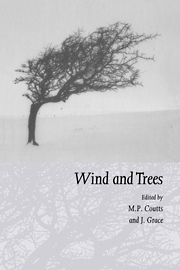Book contents
- Frontmatter
- Contents
- Preface
- List of contributors
- Part I Airflow over topography and in forests
- Part II Mechanics of trees under wind loading
- Part III Tree physiological responses
- 14 Wind-induced physiological and developmental responses in trees
- 15 Responses of young trees to wind: effects on root growth
- 16 Wind stability factors in tree selection: distribution of biomass within root systems of Sitka spruce clones
- 17 Development of buttresses in rainforest trees: the influence of mechanical stress
- Part IV Impacts of wind on forests and ecology
- Part V Risk assessment and management response
- Index
16 - Wind stability factors in tree selection: distribution of biomass within root systems of Sitka spruce clones
Published online by Cambridge University Press: 27 October 2009
- Frontmatter
- Contents
- Preface
- List of contributors
- Part I Airflow over topography and in forests
- Part II Mechanics of trees under wind loading
- Part III Tree physiological responses
- 14 Wind-induced physiological and developmental responses in trees
- 15 Responses of young trees to wind: effects on root growth
- 16 Wind stability factors in tree selection: distribution of biomass within root systems of Sitka spruce clones
- 17 Development of buttresses in rainforest trees: the influence of mechanical stress
- Part IV Impacts of wind on forests and ecology
- Part V Risk assessment and management response
- Index
Summary
Abstract
The effects of tree improvement on factors likely to influence tree stability were investigated using clonal Sitka spruce trees that had been grown for 11 years on an unploughed nursery site. The distribution of biomass between root and shoot, and within the root systems of trees from five improved clones, was examined and compared with control trees grown from unimproved cuttings and transplants. The direction (azimuth) of growth and dimensions of the main woody roots were also measured. Differences between clones were found in allocation of biomass between root and shoot, and in root system architecture. Large differences were found between clones in proportions of below-ground biomass allocated to stumps and woody roots (which function for anchorage). These results indicate that root: shoot ratio can be a poor indicator of tree stability when the stump is included as part of the root biomass. The distribution of root origins around the stump showed no significant clumping but the allocation of biomass between roots was found to differ between tree types. On average, the improved clones had allocated biomass to fewer roots than the controls. The amount of branching in the proximal 45 cm of the root system also differed between clones. Distribution of root cross-sectional area around the tree was significantly asymmetric in two of the clones. Overall, root biomass was allocated more to the lee side of the prevailing wind direction. The substantial differences found in allocation between root and shoot, and within the root system, may have implications for the wind stability of trees and could present opportunities for improving stability by clonal selection.
Introduction
Damage by windthrow causes important economic losses to forestry in northern Europe.
- Type
- Chapter
- Information
- Wind and Trees , pp. 276 - 292Publisher: Cambridge University PressPrint publication year: 1995
- 32
- Cited by



